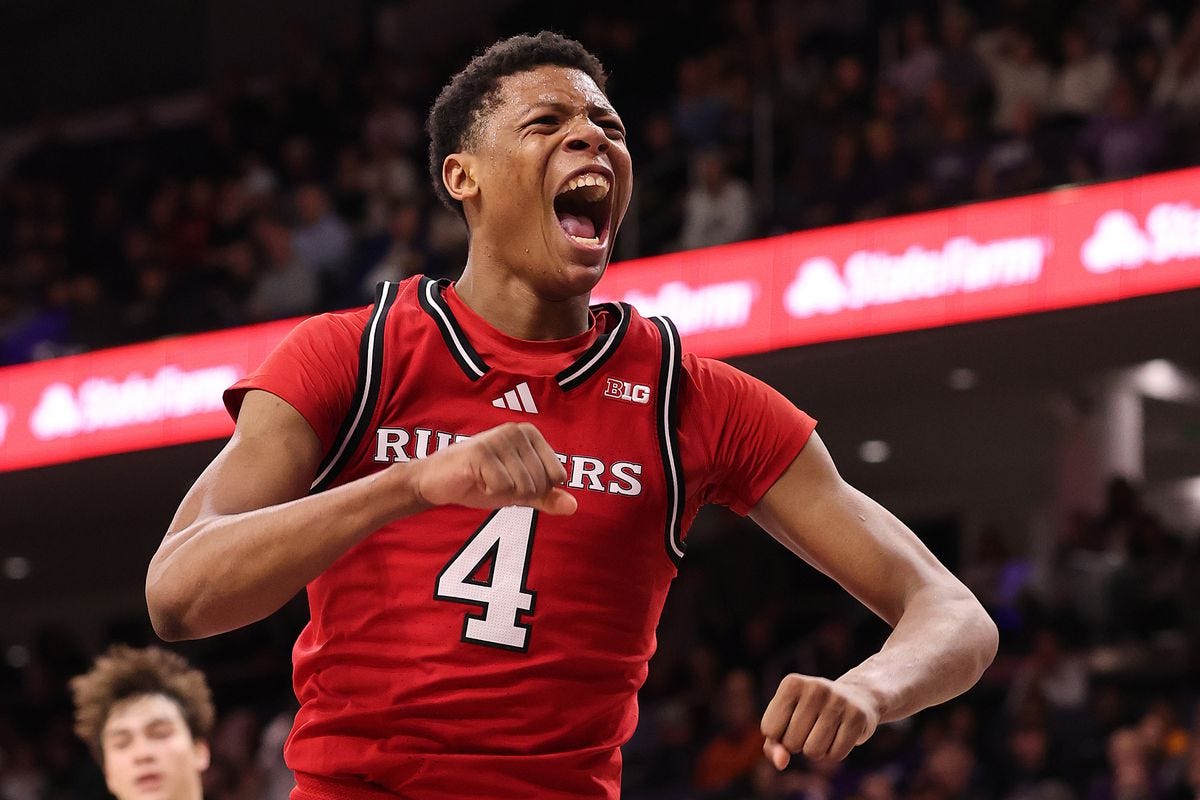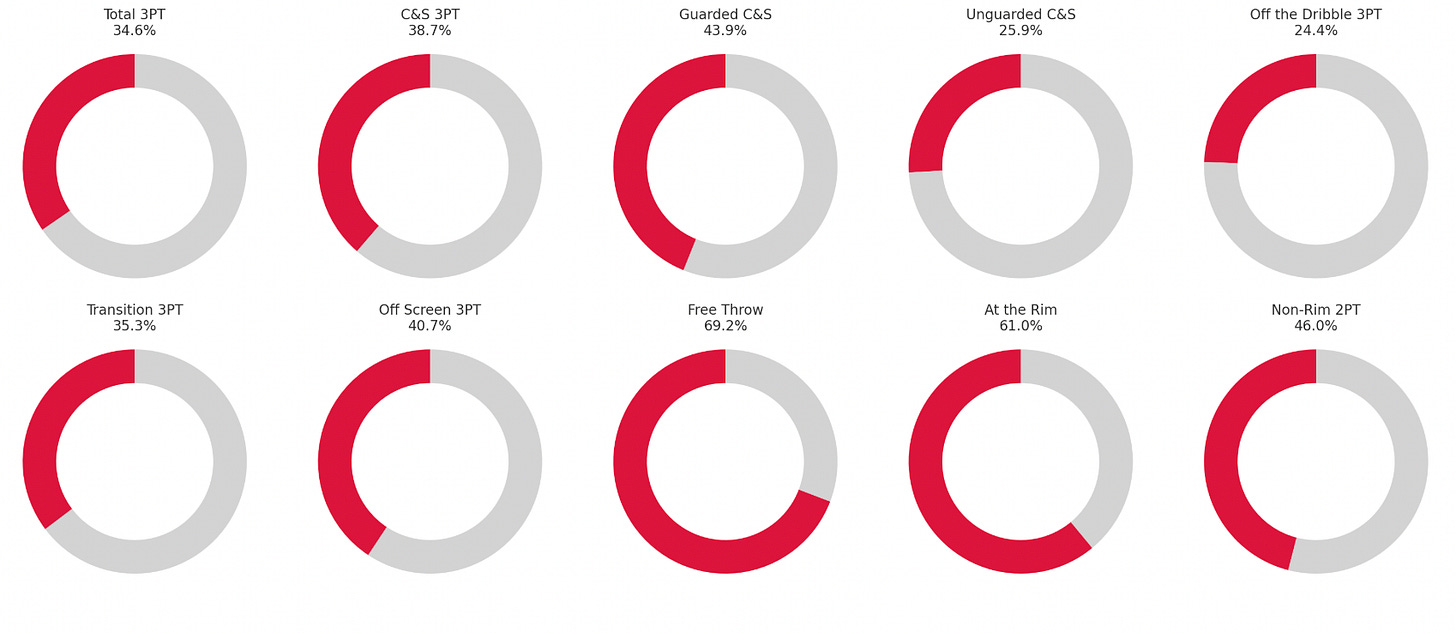Principles: Ace Bailey and How to Assess "Processing"
In other words, trying not to fall into vague generalizations about an otherwise complex game.
Just about two weeks ago, I graduated from Rutgers University with a double-major in Computer Science and Data Analytics. Given my concentration of study, work in basketball analytics now, and the hefty amount of statistics classes I took in college, one might assume I am quantitatively inclined.
Funny enough, I started college intending to become a lawyer. I competed in history bowls, studied Oyez cases, and once swore off math altogether. I bring this up not to meander—but because it reminds me of Ace Bailey. Like many freshmen, he entered a system not built to optimize him. And like I did, he may need redirection and focus, not judgment.
Bailey is a “modest” 6’7.5”, a fair bit off the 6’10” Rutgers listed him at throughout the season. That measurement would have been tough for his draft stock if it wasn’t paired with his solid wingspan (7’0.5”) and standing reach (8’11”). Throughout the season, Bailey showed some flashes of good switchability along with more consistent play as a secondary rim protector. Bailey struggles off the ball in man coverage—often caught ball-watching, missing backdoor cuts, or arriving late on rotations.
Both valid and flimsy excuses have been made for Bailey this year in light of his less than ideal situation at Rutgers. His defensive awareness, however, shouldn’t be pardoned. Motor is one of those things that is harder to project long term, but it isn’t a great sign for Bailey.
His flashes as a weak side shot blocker shouldn’t be ignored though. His block percentage (4.1%) along with the measurements should give teams more confidence that he can have a solid floor as an enhanced defender.
Bailey would do best in a system that leverages his physical advantages as much as possible rather than force him to navigate screens or make many complex rotations. As a defender, he has a high median outcome - similar to someone like Peyton Watson - who is error prone but physically advantageous for the Nuggets.
Offensively is where Bailey gets more polarizing. I have heard the KD comparisons, I’ve heard the Jabari Smith Jr. comparisons. Obviously, I tend to lean a little towards the JSJ side (and that's fine!), but there are major differences. JSJ wasn’t a particularly aggressive player - and paired with his handle - that made for a very hit or miss offensive profile. Bailey has the shotmaking gift and developed over the course of the season in finding his spots in the midrange area.
Bailey didn’t get to the rim much at all this year, with around the same number of pull-up twos as rim attempts. This is the crux of his offensive profile, and while some may ask why this is an issue - if Bailey is making his midranges, then does it matter? - it obviously doesn’t project well when defenses get better, rotations come quicker, and rim protection gets more mobile.
The above clip best demonstrates Bailey as a player - he looks to get to the rim (a previous possession showed him hitting a contested layup on the exact same drive) but the smaller defender closes his right hand off, and that catalyzes into a typical turnaround jumper, one where he shoots over two defenders and swishes it. That game was great for Bailey, hitting all types of shots - but not all games will be like that. The efficiency required to justify those shots is incredibly high—even for someone with Bailey’s touch.
Why he struggles to get to the rim is where some people may differ. I try to stay away from labeling a player as having “low basketball IQ” or being a “bad decision maker”. Ultimately, I think Bailey’s issues as a processor come from the lack of physical advantages he has against all positions. Smaller, quicker, players can stifle his handle and bigger players can goad him into taking jumpshots. And since Bailey makes them (36.4% on pull-up midranges is fine), he has been encouraged to keep going with it.
The above clip demonstrates Bailey’s shotmaking touch, of which I hope some can be extracted in a more constrained role. It’s important to note that Rutgers did not put a great offensive system around either Harper or Bailey. Very rarely did Bailey come off pindown screens or wiper actions, where I believe he could’ve been more effective than in a “creator role” (or whatever they were expecting by having him handle the ball on the baseline).
Whether Bailey can shore up some of these physical disadvantages is a bigger question. Developmental coaches might be able to tighten his handle over time (slower than one would expect) and we can reliably expect his core to strengthen too, which will allow him to enter more post-up actions against smaller players.
Where Bailey did excel was as a cutter - 75.6% TS - leveraging his explosiveness and length to cover ground was the most projectable trait he showcased over the course of the year. It bodes well for him that he understands how to attack open space without the ball and lends more credence to any concerns about his decision making. Even though it was at relatively low volume, this is one of the areas that I feel more comfortable blaming on his team environment.
I think a constrained role - similar to that of Michael Porter Jr. or a Jaden McDaniels would accentuate his most functional strengths (shots off screens, weak side shot-blocking, and open or contested catch and shoot threes) while preventing him from trying to demonstrate his isolations.
A couple things to note for him that I didn’t make the focus of this article:
His free throw percentage is low (69.2%), which makes no sense given his absurdly difficult shot diet. I’m going to guess that it will look fine in the NBA given some time - but his rookie season probably doesn’t start off very smoothly.
He shot better on guarded shots than unguarded shots all year. It’s a little baffling, but perhaps he’s able to better hone in on his touch when there’s someone rushing towards him rather than focusing on his mechanics in less urgent situations.
I was low on Bailey to start the year - this is partially because I have a tendency to dislike prospects in his archetype (was particularly low on JSJ during his draft year) and I underestimated the extent to which his team was causing some of his issues - but he’s shot up recently, to around 5th or 6th on my board (will be dropping soon). Defensively, there’s a lot to like - and the shotmaking is enough for me to put him in my top 6. I think he’ll benefit significantly from a more spaced out game, allowing him to expand his off-ball repertoire.



